This swirl Matcha Milk Bread is so light, soft, and fluffy! Pull-apart milk bread swirled with beautiful green tea matcha colors and flavor!
I discovered Hokkaido milk bread (or Shokupan) a few years back in Japan and was immediately impressed by how soft and fluffy this pull-apart bread is! I've never come across bread that is lighter and fluffier than milk bread. While I've been trying to perfect a recipe for homemade milk bread (this Hokkaido Milk Loaf), I also wanted to incorporate matcha into it.
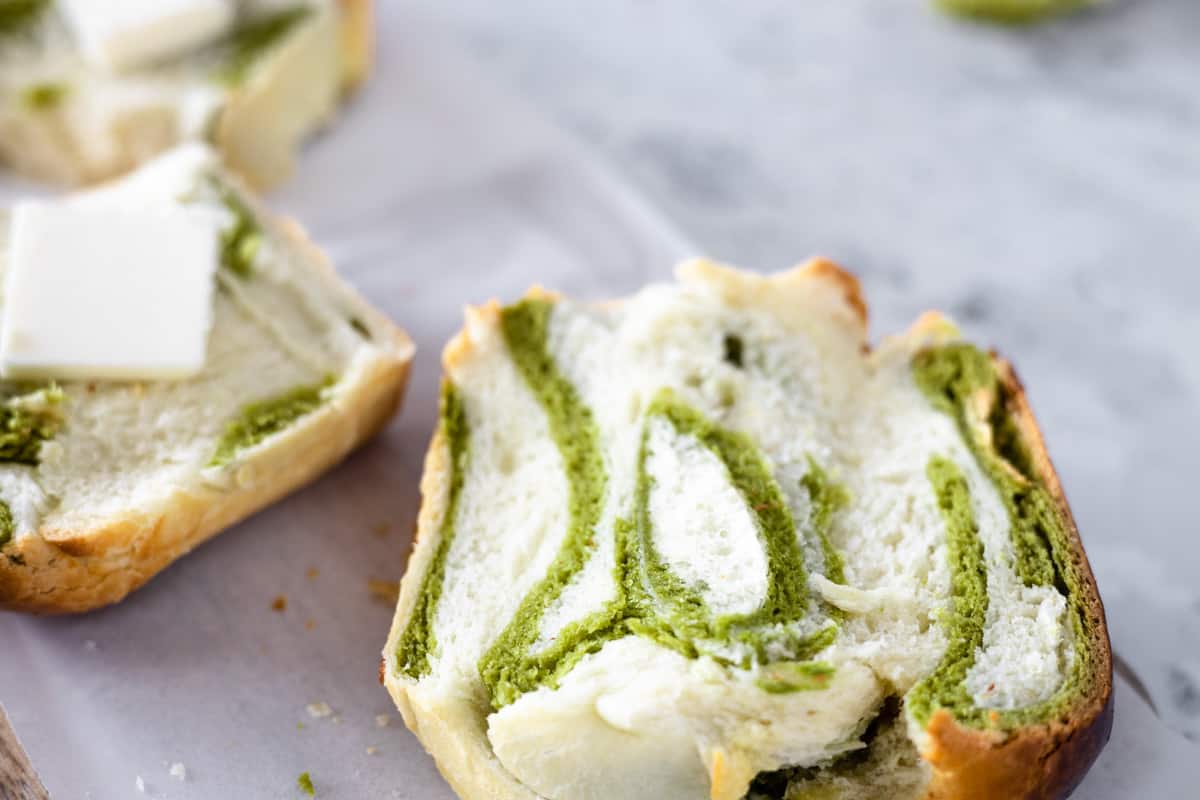
This matcha milk bread is not only flavorful and soft like regular milk bread, but also has a beautiful green swirl that can only be made using this popular Japanese ingredient - matcha green tea powder!
The recipe for this Matcha Swirl Hokkaido Loaf is made using the Tangzhong method, making this bread super soft! Making matcha milk bread at home is not complicated at all. All you need is a few basic pantry ingredients, good quality matcha powder, and a few hours of your time (to allow for proofing). This bread is amazing on it's own, or served warm with a knob of butter at any time of day!
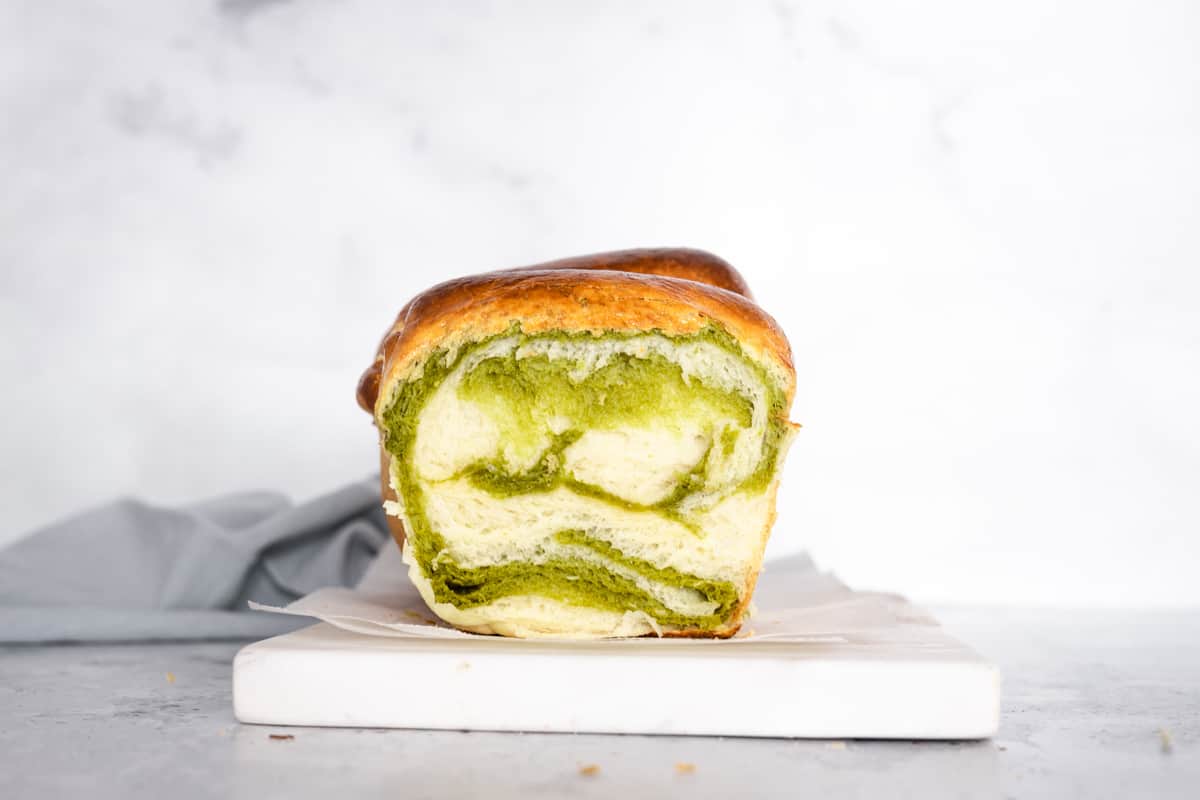
Jump to:
What is Tangzhong?
Tangzhong, which is also known as water roux, is a type of paste made using flour, water, and milk. These ingredients are mixed into a paste and cooked for a few minutes and then combined with other bread ingredients during the bread-making process.
Tangzhong paste is a very important step when making Japanese milk bread. It's what makes this Matcha Shokupan soft, airy, and light.
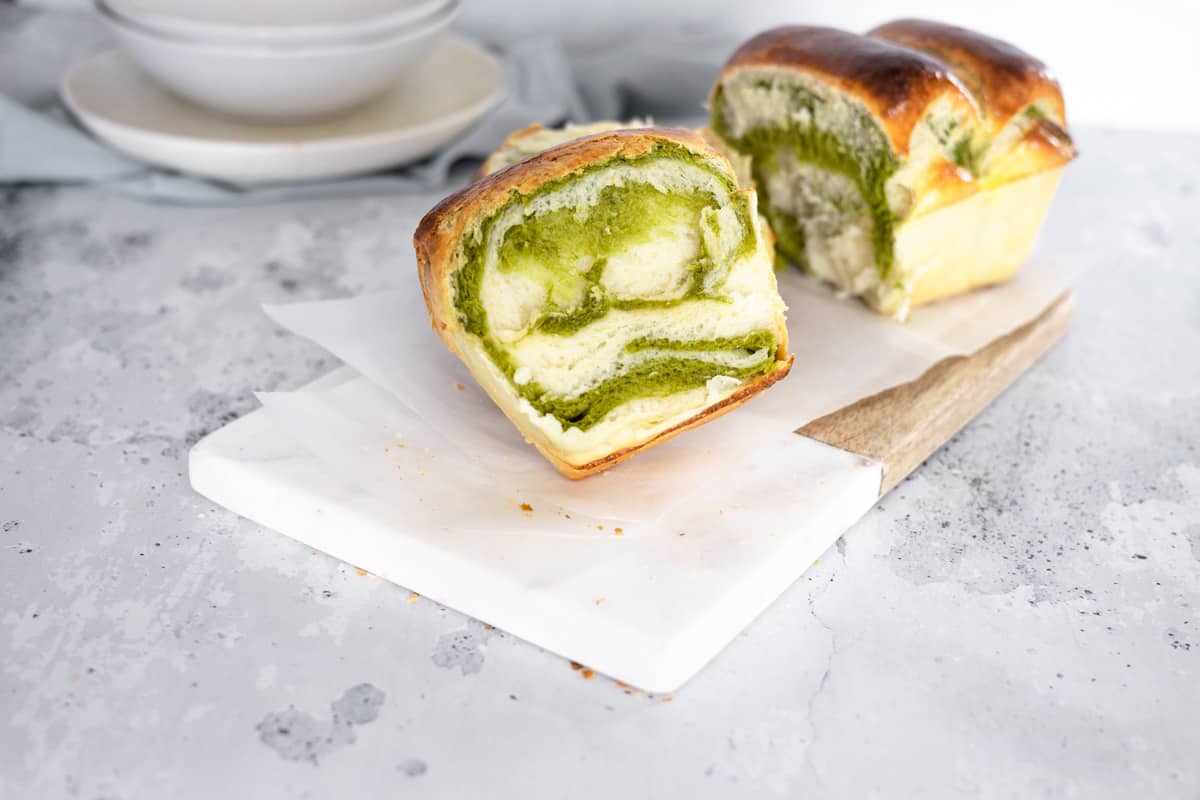
Ingredients for Matcha Milk Bread
For the first part of this recipe, or Tangzhong, you will need 3 basic ingredients:
Milk - Semi-skimmed or whole dairy milk.
Water - Room-temperature water.
Flour - All purpose or bread flour both work fine.
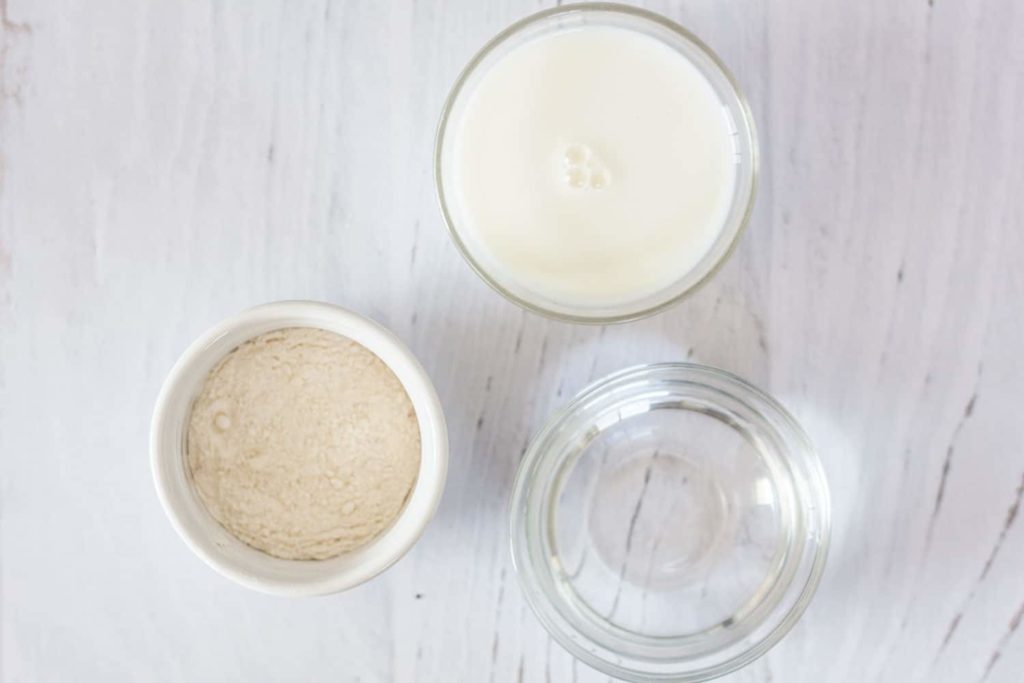
For the matcha milk loaf, you will need:
Flour - Bread flour works best. I highly suggest weighing your ingredients using digital kitchen scales for accuracy. Depending on altitude and humidity levels, you may need to add more flour to achieve the right consistency. You will also need a little extra flour for dusting the surface when rolling the dough.
Sugar - Use granulated or caster sugar. Milk bread in itself is typically slightly sweetened.
Yeast - This is what makes the bread rise during the proofing process. I always use instant dry yeast, which does not need to be proofed and can be added directly to the dry ingredients. You can also use active dry yeast, but make sure to proof this in some of the water (which needs to be lukewarm) for 5-10 minutes before using.
Salt
Egg
Milk - You can use semi-skimmed or whole dairy milk.
Butter - Use unsalted butter, softened, and cut into small cubes.
Matcha - Use premium, high-quality matcha powder. It doesn't need to be the most expensive matcha out there, but avoid using culinary-grade matcha as this tends to lose its color and brown once baked.
For the egg wash, you will need a small egg and some milk.
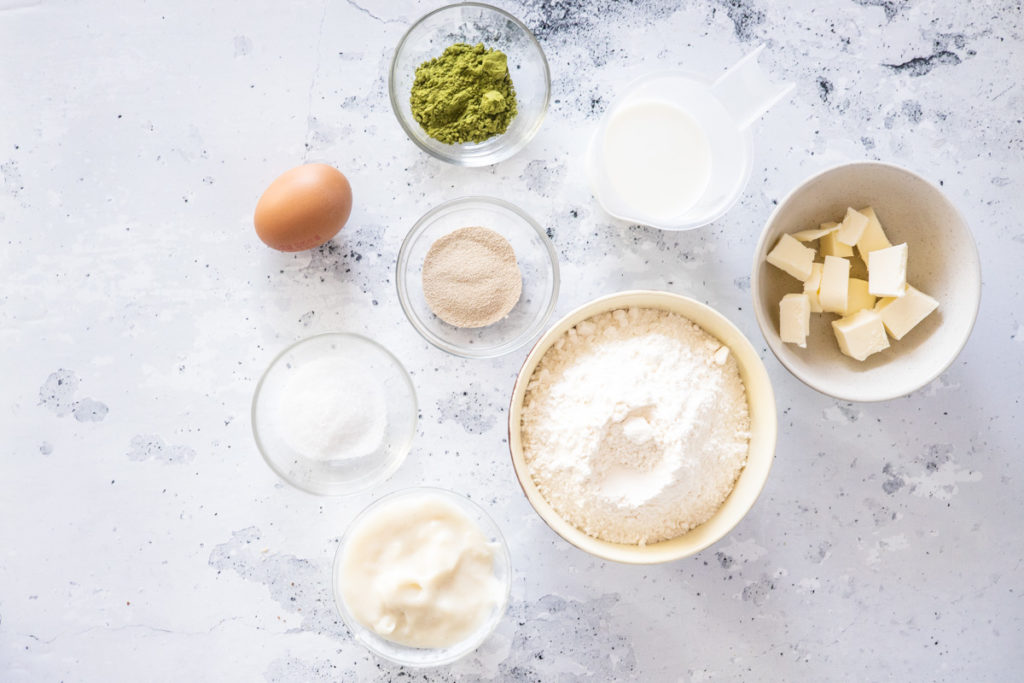
Equipment for Milk Bread
To make the Tangzhong, you will need:
- Measuring cup and weighing scales
- A small saucepan
- Whisk
- Glass bowl
- Cling film (if making ahead and refrigerating overnight)
For the matcha marble milk bread, you will need the following equipment:
- Measuring cup and weighing scales
- Sieve
- Large mixing bowl
- Stand mixer fitted with the bread hook attachment
- Spatula
- 2 oiled glass bowls for proofing the bread
- Cling film
- Rolling pin
- 9x5" (or similar) loaf tin
- Pastry brush
- Wire rack for cooling
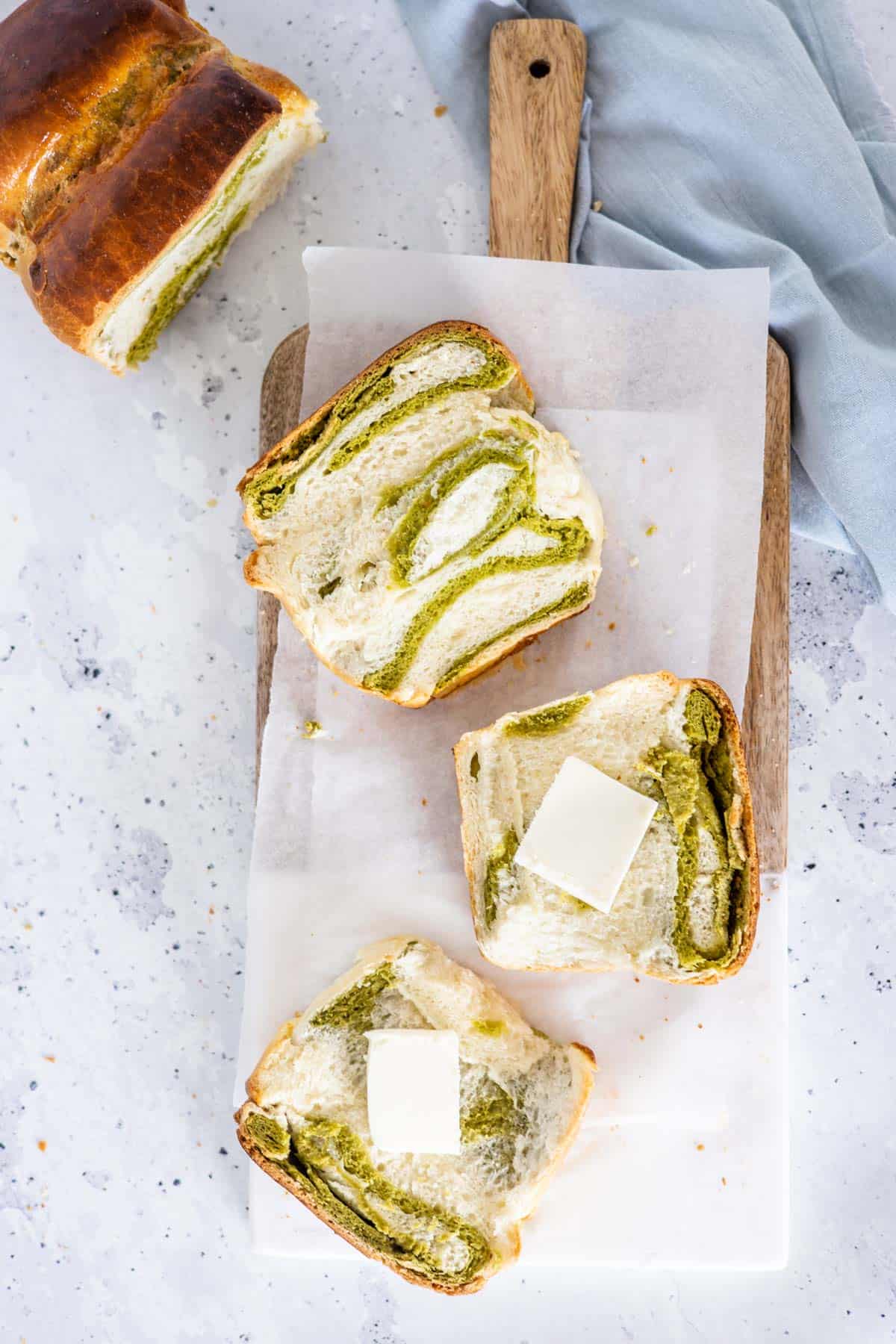
How to Make Matcha Milk Bread
Step 1: Make the Tangzhong
To make Tangzhong, place milk, water, and flour in a small saucepan on medium heat. You need to whisk continuously, until a paste is formed, to avoid the formation of any lumps.
Heat for 1-2 minutes, or until a thick slurry forms. Transfer Tangzhong to a glass bowl and cool to room temperature before using.
You can make Tangzhong up to one day ahead, cover with cling film, and chill overnight. Bring out to room temperature before using.
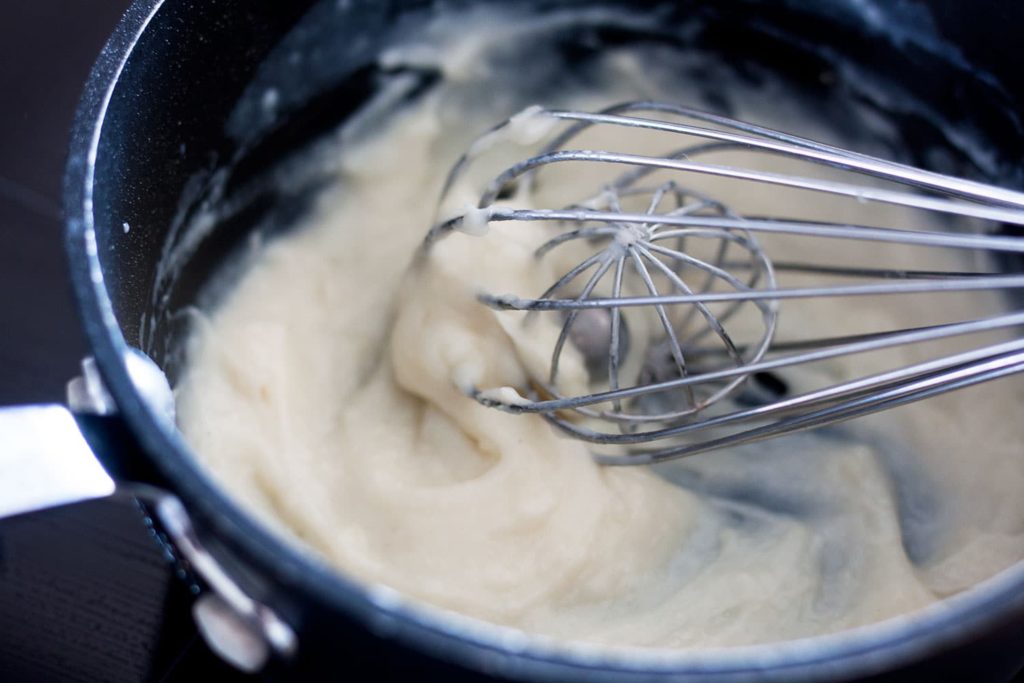
Step 2: Make Bread Dough
Once the Tangzhong has cooled down to room temperature, sift flour, yeast, sugar and salt into a large mixing bowl of a stand mixer fitted with the bread hook attachment.
Make a well in the center and add the Tangzhong, milk, and egg. Star mixing on medium speed, until ingredients are combined. Scrape any ingredients from the side of the bowl using a spatula.
With the mixer still on, add cubed softened butter gradually to the dough. Continue kneading on medium speed until dough is smooth and pulls from the side of the bowl. This will take around 7 to 10 minutes.
NOTE: at first, the dough will stick all over the bowl. As the butter incorporates, the dough will start pulling from the side of the bowl and form a smooth “ball”. If the dough is too sticky, add 2-4 tablespoons of flour. If its too dry, add 1-2 tablespoons of milk or water.
Transfer around ⅔ of the dough to a lightly oiled glass bowl and cover with cling film.
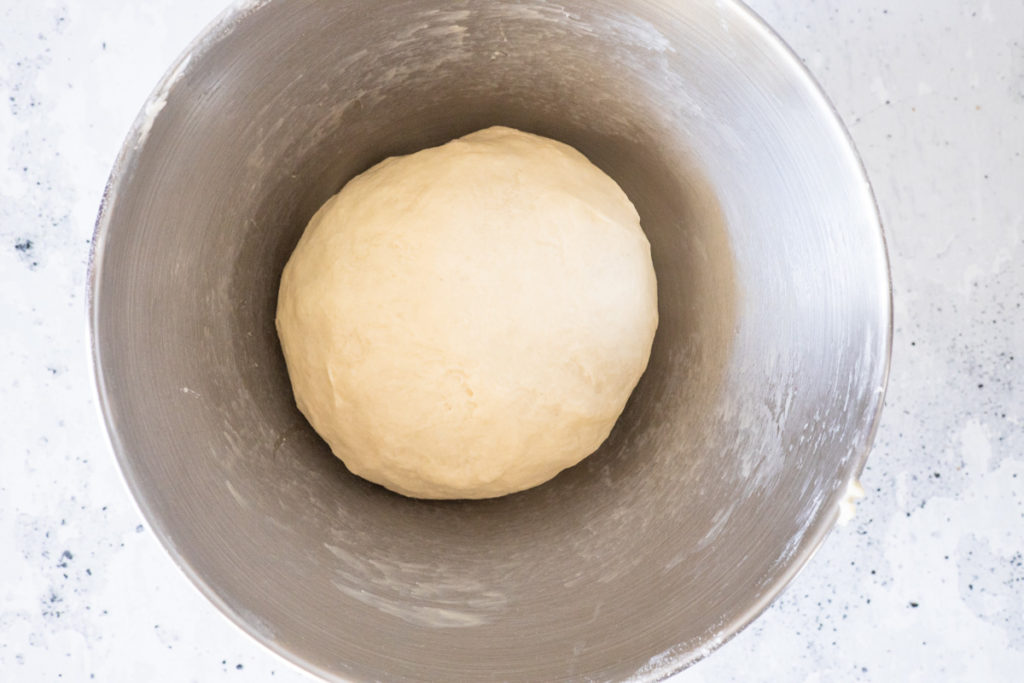
Step 3: Make Matcha Bread Dough
Leave the remaining ⅓ of the dough in the mixing bowl. Add sifted matcha powder and mix for 1-2 minutes or until matcha is combined and dough turns green.
Transfer matcha dough to a separate lightly oiled glass bowl and cover with cling film.
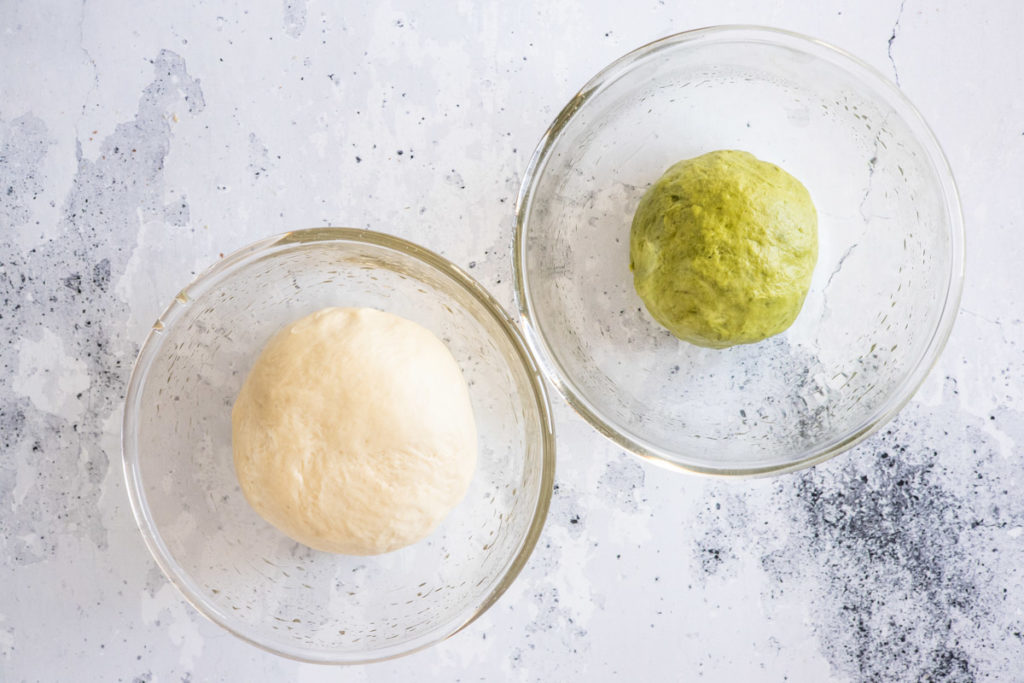
Step 4: First Rise
Transfer glass bowls with plain and matcha dough to a warm area in your kitchen and allow to proof for 1 - 2 hours, or until doubled in size.
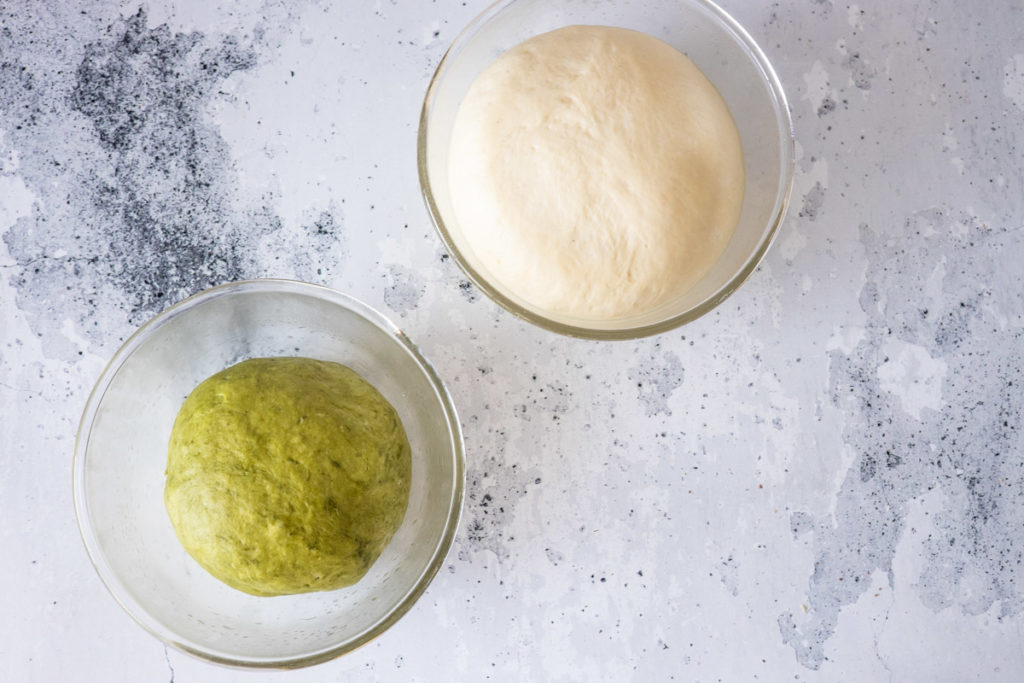
Step 5: Assemble Bread Loaf
Once both bread doughs have doubled in size, punch the dough and divide each piece into 4 equal-sized balls (you should have 4 white pieces of dough and 4 pieces of matcha-dough). You can weigh the dough for accuracy.
Place a piece of white dough on a lightly-floured surface. Roll out dough to around 6 inches in length (15cm). Repeat the process using a piece of matcha dough (these will be shorter - around 5 inches in length).
Place the matcha dough on top of the white dough and using light pressure, roll out both pieces of dough slightly so that they stick together. Fold one side of the dough halfway over the other side of the dough, then fold the other side over to the top (you should have three layers). Then, roll the resulting dough like a Swiss roll or cinnamon roll.
Repeat these steps with the remaining pieces of dough, to end up with 4 rolls of dough.
Step 6: Second Rise
Grease a 9x5" loaf tin with oil or butter. Transfer each piece of rolled dough into the loaf tin, with the seam side down. If the width of the rolled dough is longer than that of the loaf tin, lightly "push" in the sides.
Cover the loaf tin with plastic wrap and allow the bread to proof in a warm place, for 30 minutes to 1 hour - or until the dough rises to the top of the loaf tin.
In the meantime, preheat the oven to 180°C (356F).
Step 7: Bake
Use a pastry brush to brush the loaf with egg wash (mix 1 egg with 1 tablespoon of water), then bake for 25-35 minutes or until the bread reaches an internal temperature of around 90°C (194F).
Allow bread to cool in the loaf tin for 5-10 minutes, then transfer to a wire rack to continue cooling. Slice milk bread once it has completely cooled down.
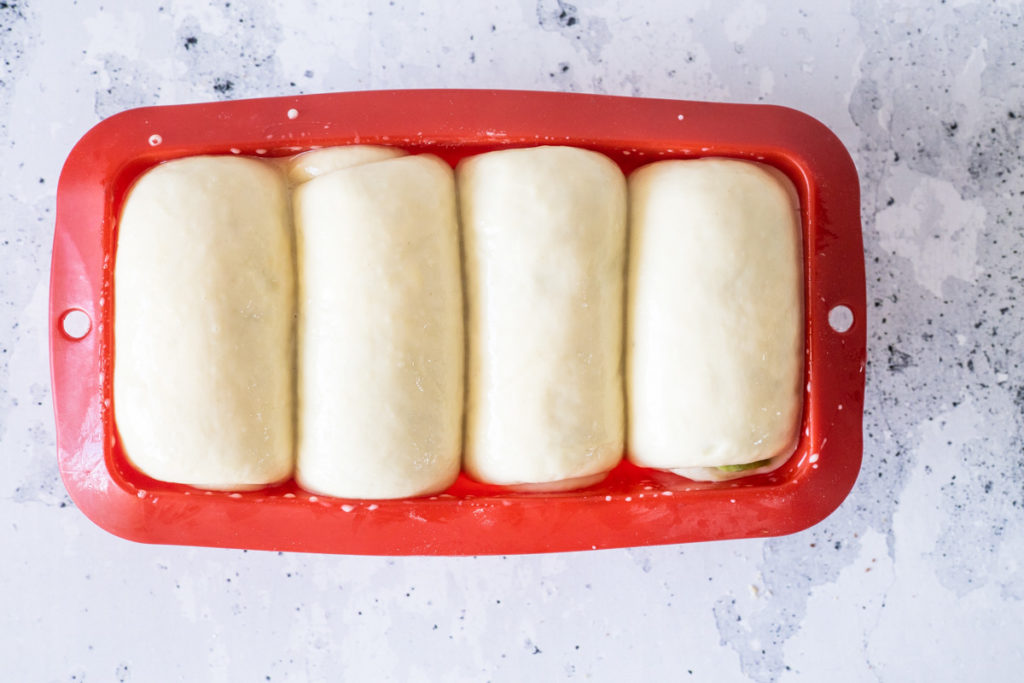
How to Store Milk Bread
Once the milk bread has cooled down completely, store in an airtight container at room temperature for up to 3 days. Milk bread is best served fresh on the day of baking.
FAQs
Although milk bread tastes best when freshly baked (since it contains no preservatives), you can also slice cooled bread and freeze each slice separately in cling film for up to 3 months.
Thaw the bread overnight and reheat in a microwave for a few seconds before serving.
Use high-quality matcha powder to get a beautiful vibrant green color. Avoid using culinary-grade matcha as this tends to turn brown upon baking.
There are a number of factors that can make the dough sticky/dry, including inaccurately weighing ingredients, the size of egg used, and humidity/altitude.
First, make sure to weigh your ingredients using digital kitchen scales for accuracy.
If the dough is too sticky, add 2-4 tablespoons of flour while kneading. If it is too dry, add 1-2 tablespoons of milk or water and continue kneading.
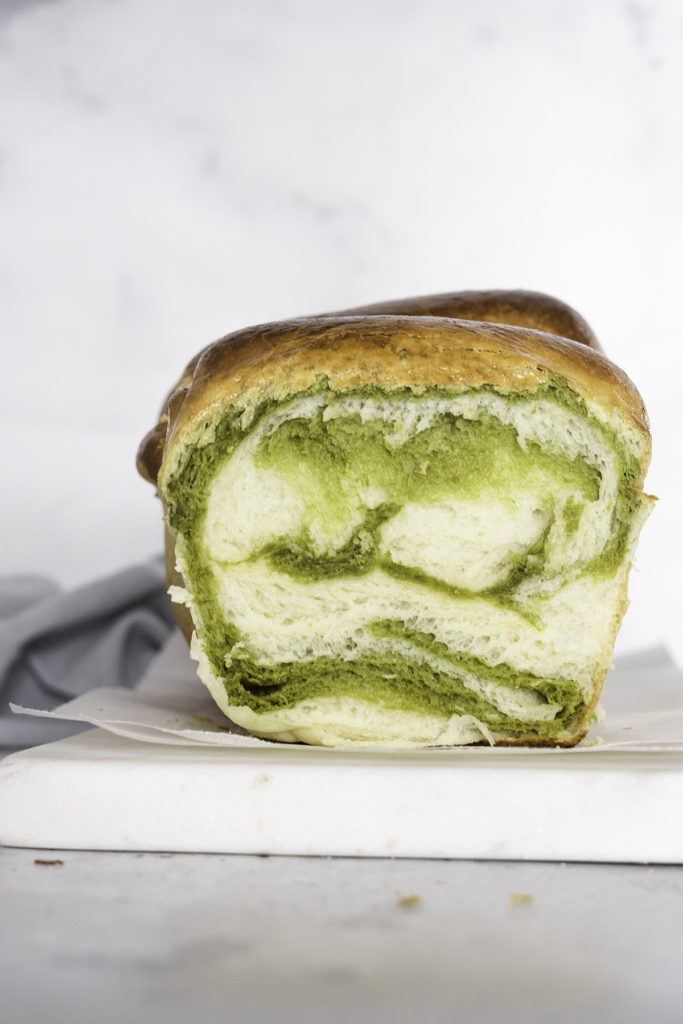
Other Matcha Recipes
Matcha Cream Puffs
Matcha Crinkle Cookies
Matcha White Chocolate Brownies
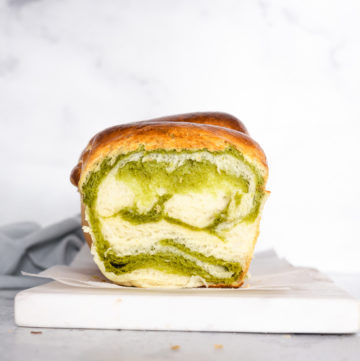
Matcha Milk Bread
Ingredients
Tangzhong
- 60 mL milk semi-skimmed or whole (¼ cup)
- 60 mL water (¼ cup)
- 25 g flour AP or bread flour (approx 3¼ tbsp).
Milk Bread
- Tangzhong room temperature
- 340 g bread flour (+ extra as needed and for dusting)
- 2 tbsp granulated sugar
- 7 g instant yeast
- ½ tsp salt
- 1 egg medium-sized, room temperature
- 120 mL milk semi-skimmed or whole
- 60 g unsalted butter softened and cut in cubes
- 2 tsp. high-quality matcha
Egg Wash
- 1 small egg
- 1 tbsp. milk
Instructions
Tangzhong
- Place water, milk, and flour into a small saucepan on medium heat, whisking continuously to avoid lumps.
- Heat for 1-2 minutes, until a smooth and thick slurry forms and turn off heat. Transfer Tangzhong to a small glass bowl and cool completely before using. If making ahead, chill overnight and thaw to room temperature before using.
Milk Bread
- Place sifted flour, instant yeast, sugar, and salt into a large mixing bowl of an electric mixed fitted with the bread hook attachment. Add egg, milk, and cooled Tangzhong.
- Mix on medium speed for 2-3 minutes until combined. Scrape any ingredients from the side of the bowl using a spatula.
- Whilst still mixing, gradually add cubed softened butter. Continue kneading on medium speed until dough is smooth and pulls from the side of the bowl, around 7-10 minutes. (Please note, at first, the dough will stick all over the bowl. As the butter incorporates, the dough will start pulling from the side of the bowl and form a smooth “ball”). If the dough remains sticky, add 2-4 tbsp. of bread flour. If it is too dry, add 1-2 tbsp. of water or milk.
- Transfer around ⅔ of the dough to a lightly oiled glass bowl, cover with cling film, and place in a warm area.
- Add matcha powder to the remaining ⅓ of the dough and knead for a further 2-3 minutes using the bread hook attachment, or until matcha is incorporated and dough becomes green. Transfer matcha dough to a separate glass bowl (lightly oiled), cover with cling film, and place in a warm area.
- Allow white and matcha doughs to proof in a warm place for 1½-2 hours, or until doubled in size.
- Once doubled in size, punch the dough and divide each piece into 4 equal-sized balls (you should have 4 white pieces of dough and 4 pieces of matcha-dough). You can weigh the dough for accuracy.
- Start by placing a piece of white dough on a lightly-floured surface. Roll out dough to around 6 inches in length (15cm). Repeat the process using a piece of matcha dough (these will be shorter - around 5 inches in length).
- Place the matcha dough on top of the white dough and using light pressure, roll out both pieces of dough slightly so that they stick together. Fold one side of the dough halfway over the other side of the dough, then fold the other side over to the top (you should have three layers). Then, roll the resulting dough like a Swiss roll or cinnamon roll.
- Repeat the previous 2 steps for the remaining pieces of dough. You should end up with 4 rolls of dough.
- Lightly grease a loaf tin with butter. Place each piece of rolled dough into the loaf tin, with the seam side down. If the width of the rolled dough pieces is longer than that of the loaf tin, lightly "push" in the sides.
- Cover the loaf tin with plastic wrap and allow to proof in a warm place, for 30 minutes to 1 hour - or until the dough rises to the top of the loaf tin. In the meantime, preheat the oven to 180°C (356F).
- Brush the dough with egg wash (mix 1 egg with 1 tbsp. milk) and bake for 25-35 minutes or until the bread reaches an internal temperature of around 90°C (194F).
- Allow bread to cool in loaf tin for 5-10 minutes, then transfer to a wire rack to continue cooling. Slice milk bread once it has completely cooled down.

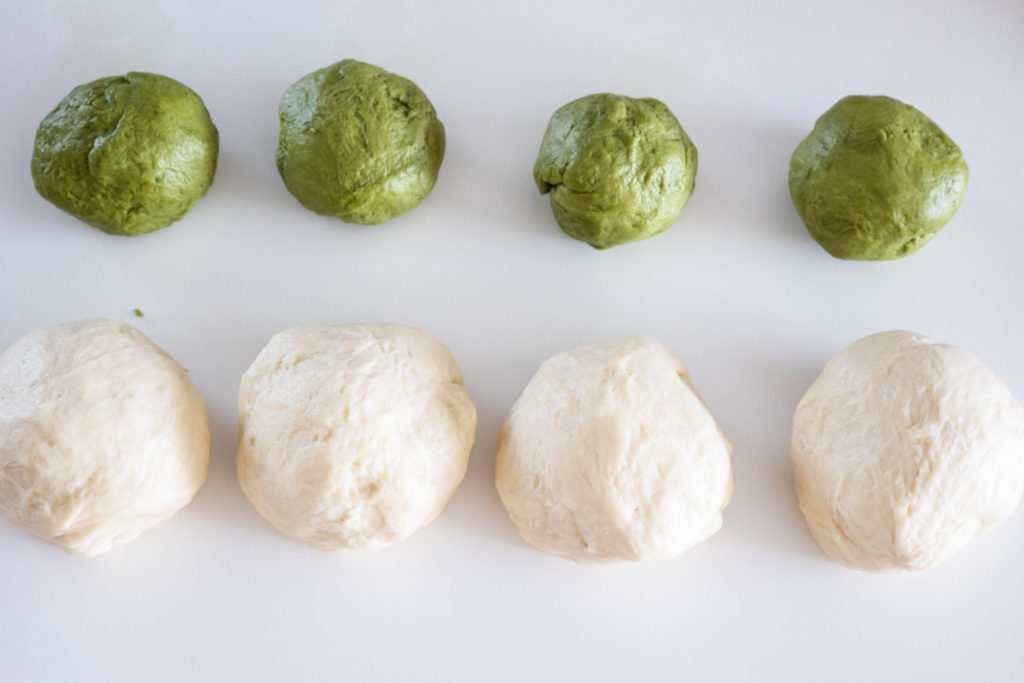
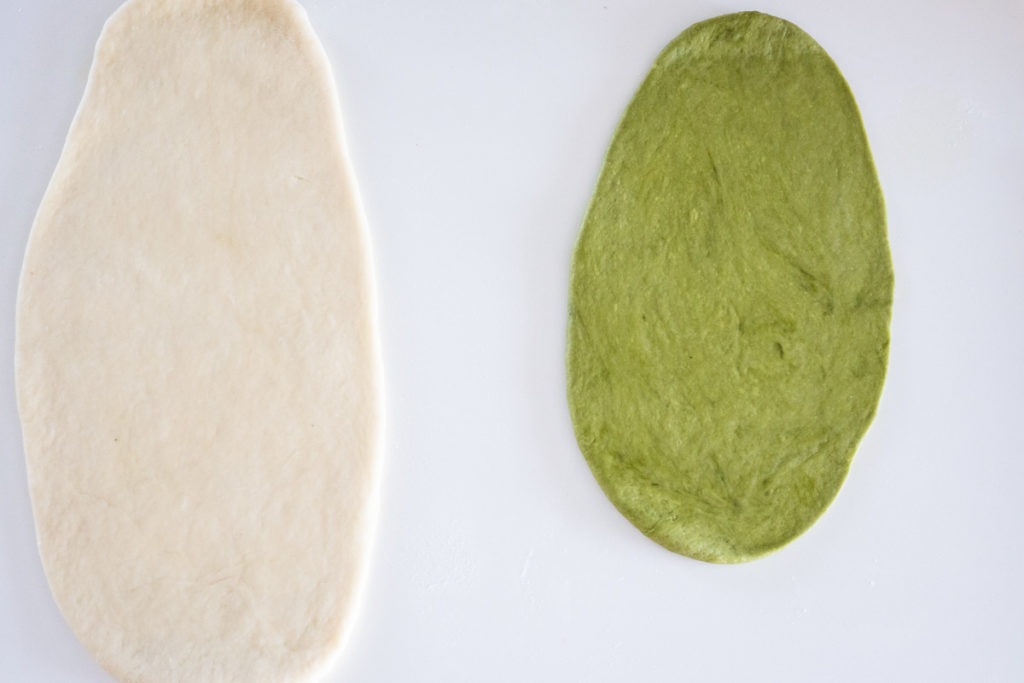
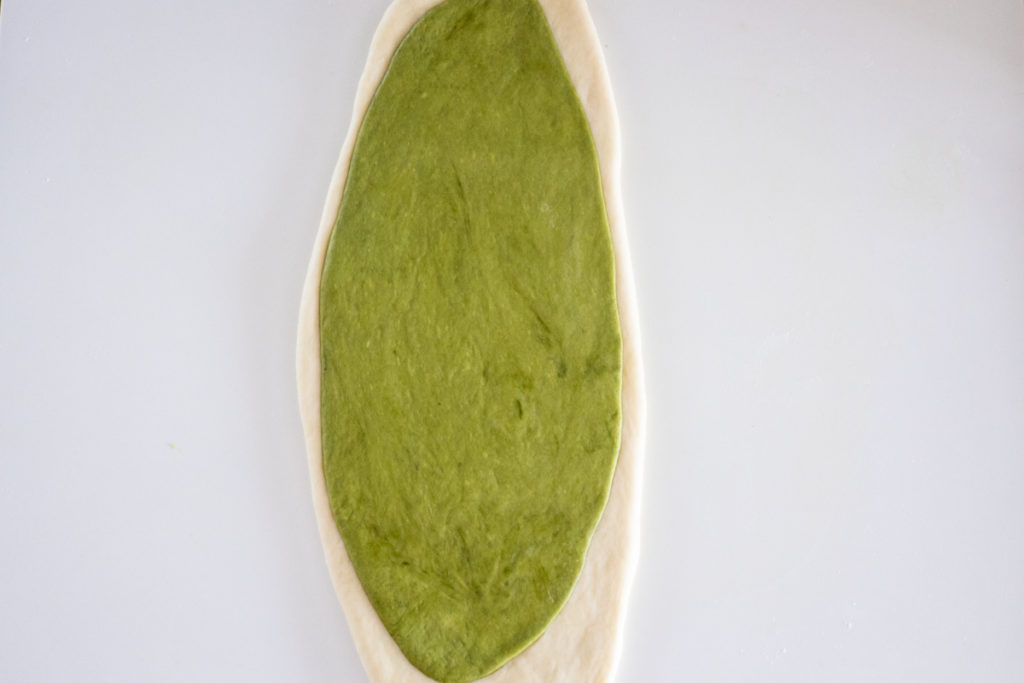
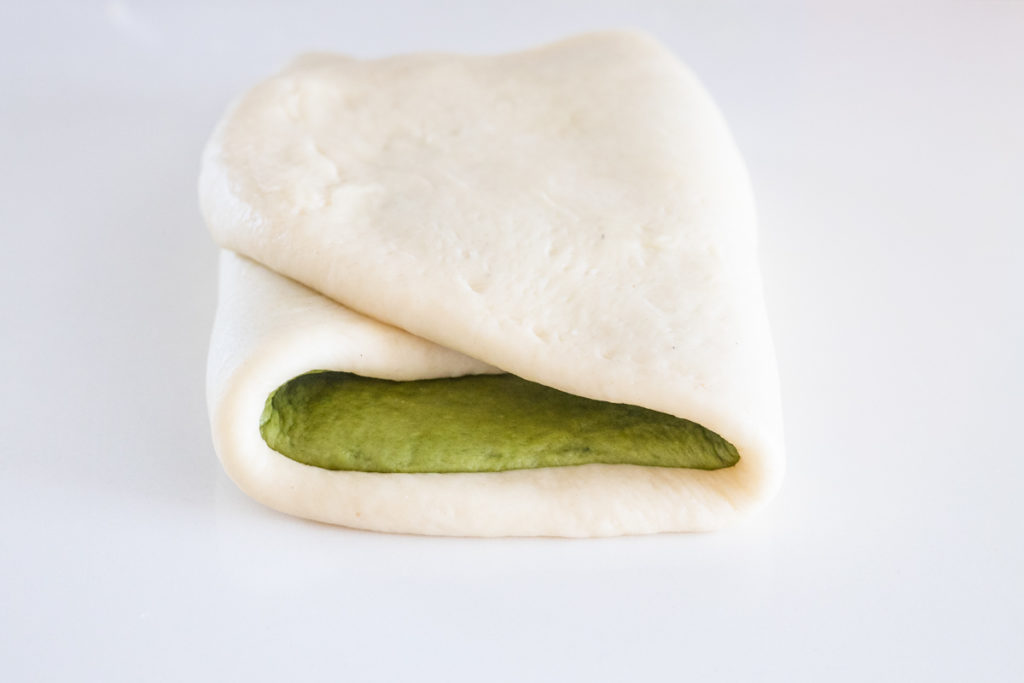
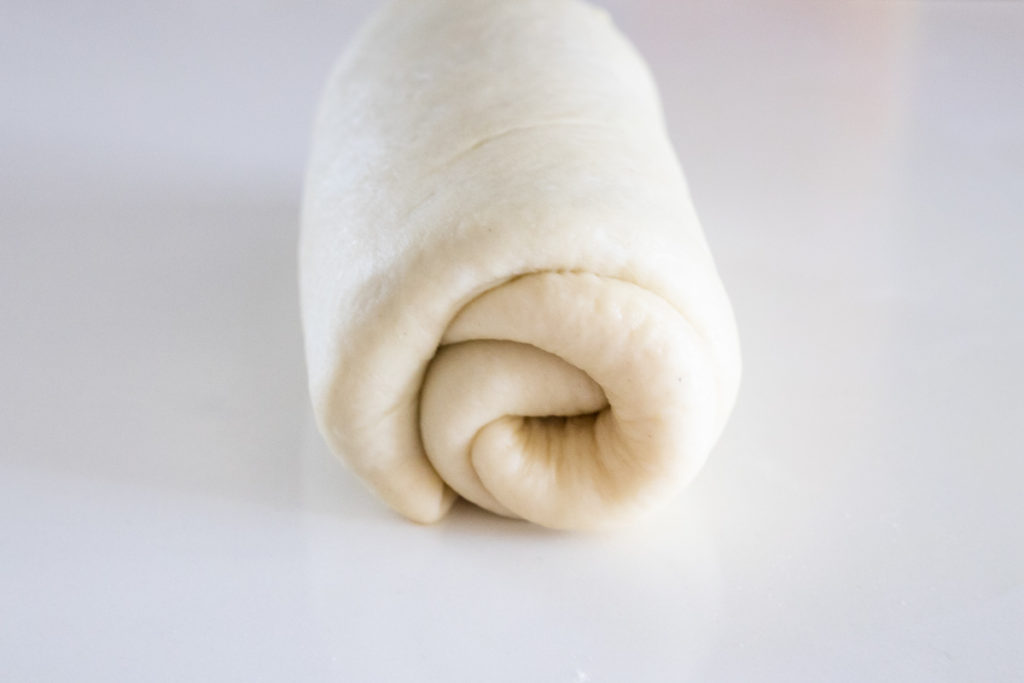
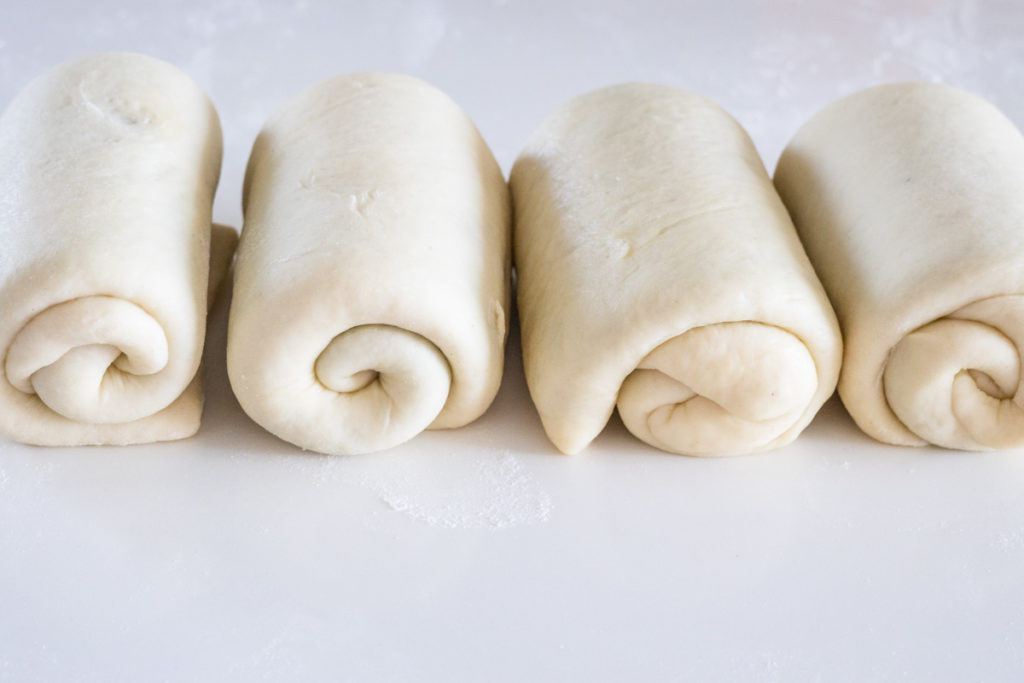
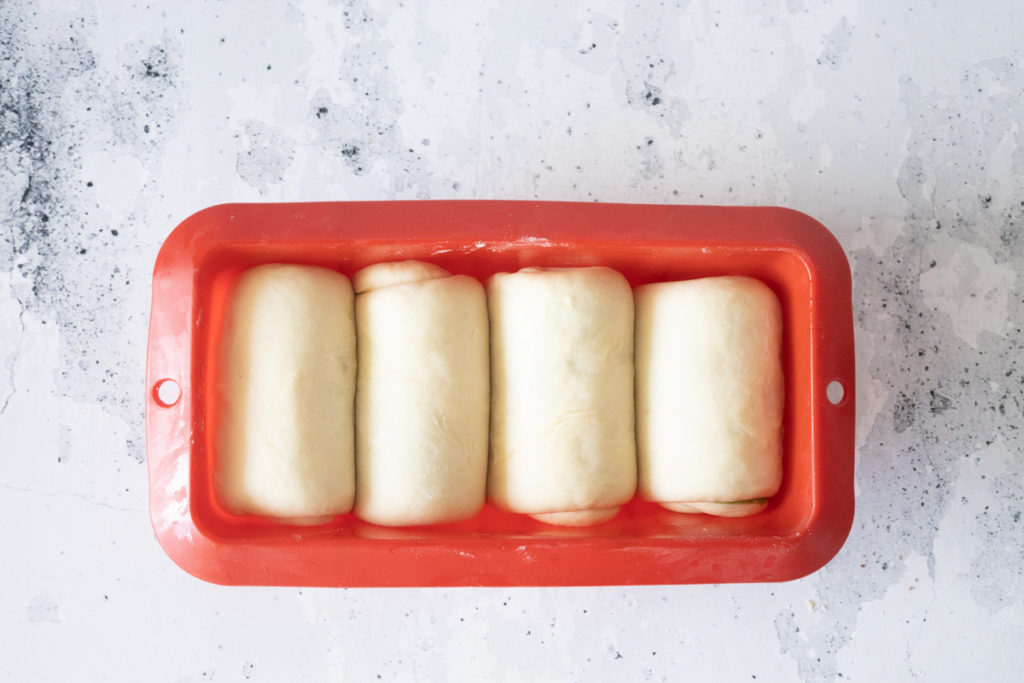
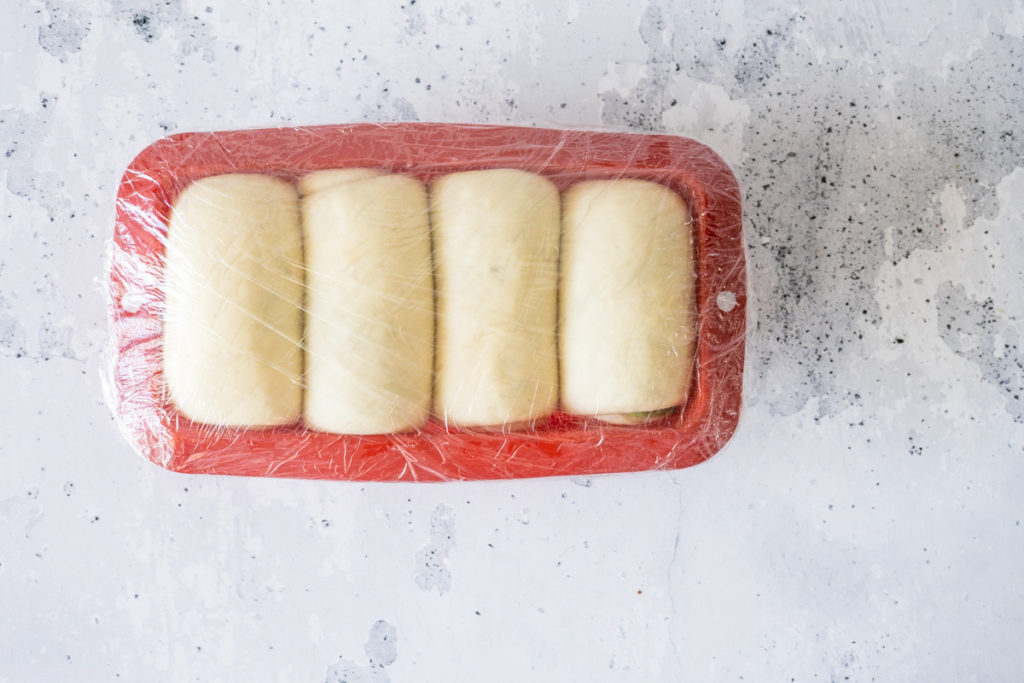
Leave a Reply